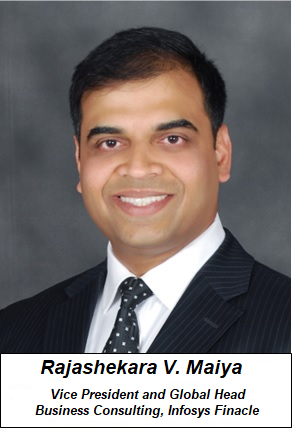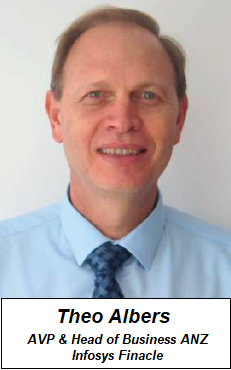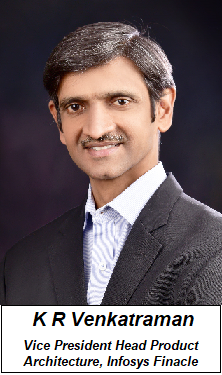Research for the Infosys Modernization Radar 2022 found that 88 percent of the systems in organizations were legacy, and more than half of those were core to the business. A huge majority of legacy systems were on course for modernization within five years.
This is true of banking as well. However, while many banks are keen on core transformation, they could become overwhelmed by its complexity. Despite making significant investments over a decade or so, only 16 percent of financial institutions agree that they have managed to transform at scale and obtain full value. Two reasons stand out: the rapid evolution of customers, competition and technology keeps moving the transformation goalpost forward; secondly, most modernizations are incomplete because in focusing on the front-office, they fail to address mid and back-office functionality such as service effectiveness or personalized product creation.
Hence it is critical for a bank to find the right solution and technology partner that can help it achieve the best outcomes from core modernization. Based on our experience, we believe the following eight criteria are key to making the right choice:
Functional richness: Composability is one of the biggest changes to have occurred in the modern core banking platform. But when choosing a composable solution, a bank should also ensure it covers all the banking verticals/ sub-verticals that it serves. For example, a corporate bank catering to the MSME, SME, mid-market and corporate segments, would need a solution that allows it to compose products and services for all of them. Other important solution requirements include depth of capability – for instance, support for syndicated, and not just basic lending – and a functional roadmap aligned with the bank’s own business expansion plans.
Technology prowess: Most banks will want a cloud-native solution. Given that different vendors interpret this differently, our recommendation is to go with a solution that follows the CNCF 12-factor cloud-native framework. In the age of open banking, every bank needs a core solution designed for open integration via APIs and webhooks. Also, the selected vendor must have plans for significant investments in emerging technologies, especially AI and edge computing, which will make a big impact on core systems design going forward.
Depth of services: It is well-known that people make the real difference in any transformation. Therefore, the technology partner’s team should have people with core transformation experience in the country, and platform, of implementation. Competence apart, the bank should ensure the vendor has adequate capacity to see the transformation through; this is because there will be many transforming banks competing for the same talent pool. At the time of choosing the solution/ vendor, the bank must insist on a team of certified professionals to work on its project.
Long-term viability: Even with a composable core, modernization is a long-term endeavor that will likely take several stages to complete. Banks need a partner who can go the distance, one with a long-term outlook and viability. This may be an issue with venture capital-funded providers, whose long time-to-value creation often exceeds their VC’s expectations. More than a billion dollars have been invested in core banking vendors in the last decade, but the collective revenues of a bunch of companies is less than a hundred million. Many of these businesses may not be able to sustain through a funding winter. Therefore, it is critical to check the prospective vendor’s growth and profitability trends, and long-term viability, before signing up.
Customer references: References from other banks – especially of a similar size and persona as the bank undergoing transformation – are very valuable in the selection decision. Also, because banking practices vary from country to country, a vendor with proven credentials in the market of choice, which has built the adapters to connect to its infrastructure, and has understood local requirements, has a clear advantage.
Operational performance: Rapid digital adoption is sending digital transactions soaring. And as open banking and finance penetrate further, there appears to be no limit to the growth. (For example, in India, real-time open payment transactions have crossed 8 billion per month). Core banking solutions need to be highly resilient to withstand this scale of transaction in general, plus the occasional spike on special days like Boxing Day 2022 in Australia which saw record-breaking sales.
Partner ecosystem: Not just scalable and resilient, a core banking platform also needs to be agile and extensible so a bank can add on differentiating capabilities that are not part of the vendor’s package. The existence of a rich partner ecosystem around the core is also an important consideration, because core banking is going the way of consumer platforms to become the “Operating System” of the banking applications landscape. The good news is that most providers have created an ecosystem of partners who build on top of their solutions. Last but not least, a bank should know about the vendor’s technology alignments: for example, is the vendor’s platform cloud-agnostic or tied to any particular provider?
Total cost of ownership: The last, and by no means least, criterion in core platform selection is the total cost of ownership. Core transformation is expensive, entailing a sizeable solution acquisition cost followed by ongoing expenses. However, a bank can optimize its cost by choosing a core solution that uses several open-source components in its stack, and offers economical maintenance, including preventive maintenance, options.
That being said, all contemporary core solutions offer a significant cost advantage versus legacy systems. And while core transformation is a serious investment, over the medium and long-term it delivers value that is several times its cost.
Finally
To make sure they extract every dollar of that value, banks should consider the above eight criteria, assigning different weightage to each, based on their contexts and needs. The right selection will make all the difference to their core transformation outcomes.
About the Authors:
Rajashekara V. Maiya
Vice President and Global Head- Business Consulting, at Infosys-Finacle

Rajashekara Maiya is responsible for Business Consulting at Finacle, which includes Pre-sale, Solution Architecture, Account Mining, Digital offering. Previously he was responsible for charting the product strategy of Finacle, the flagship banking solution of Infosys. This role included responsibility for, defining the detailed product roadmap, Strategic acquisition & alliance partner identification & management, client engagement and representation of the company with external stakeholders such as analysts and media. He also was responsible for the Cloud Business for Finacle, including charting our strategies for Cloud Hosting, working with Cloud Infrastructure providers. Further, he was responsible for the Eco-system collaboration and bringing out point applications in the banking space and Fintech engagements. Maiya has been quoted in publications such as Forbes, The Banker, Banking Technology and the Economic Times. He is also visiting faculty to many universities, and speaks regularly at SIBOS, Asian Banker, MEED and others. He is on the expert panel of the McKinsey Quarterly, a member of the XBRL Abstract Modelling Task Force (AMTF) Group. He is also the co-author of book “SMACing the Bank” which was released in November, 2017.
Theo Albers 
AVP & Head of Business – ANZ, Infosys Finacle
Theo heads the business for Infosys Finacle for the Australia and New Zealand market, supported by a team comprising of sales, business consulting, pre-sales, delivery and marketing. He comes with a strong technical background, and ample experience in complex multi stakeholder strategic delivery programs. From his many years of experience Theo has good knowledge of banking software functional capabilities, ability to design solution offerings and services to support customers strategic objectives by applying technology to address real world problems.
K R Venkatraman
Head Product Architecture, Infosys Finacle
K R Venkatraman (KRV) brings over 28 years of global technology experience in international banking and technology transformations. His experience spans multiple core banking vendors, start-up ecosystem and experience with clients through their digital transformation journey across multiple markets globally.
in international banking and technology transformations. His experience spans multiple core banking vendors, start-up ecosystem and experience with clients through their digital transformation journey across multiple markets globally.
In his current role, KRV is the chief technical architect of the Finacle suite of products. He is responsible for defining and executing the technology strategy for the products. He provides technical leadership to our software development teams. He has also been leading the technology transformation journey of Finacle into a cloud native product. He has been working along with Finacle architecture and product engineering teams in introducing contemporary architecture into our products in a pragmatic manner.